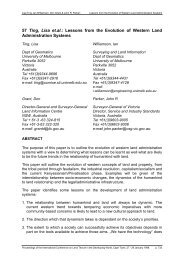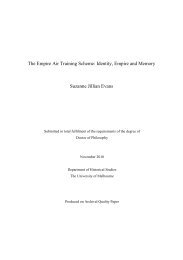Speculum - University of Melbourne
Speculum - University of Melbourne
Speculum - University of Melbourne
You also want an ePaper? Increase the reach of your titles
YUMPU automatically turns print PDFs into web optimized ePapers that Google loves.
38 SPECULUM<br />
agreed proportion <strong>of</strong> students to each <strong>of</strong><br />
the teaching hospitals.<br />
The new Royal <strong>Melbourne</strong> Hospital provided<br />
admirably for the comfort and convenience<br />
<strong>of</strong> students and lecturers. The<br />
members <strong>of</strong> its clinical school carried on<br />
the tradition <strong>of</strong> patient and exacting instruction<br />
begun by men like Williams and<br />
Stawell and continued by the remarkable<br />
group <strong>of</strong> practitioners and teachers which<br />
included Sir George Syme, Sir Alan Newton,<br />
Sir Victor Hurley, Sir Sidney Sewell, Dr.<br />
Leslie Hurley, Dr. H. H. Turnbull and Dr.<br />
S. 0. Cowen.<br />
In 1936 the university council agreed that<br />
departments <strong>of</strong> medicine and surgery would<br />
be created if the new Royal <strong>Melbourne</strong><br />
Hospital provided clinical wards for their<br />
use. Negotiations for the departments<br />
began in 1949 between the university and<br />
the teaching hospitals. In 1950 the hospital's<br />
committee <strong>of</strong> management and the<br />
governing bodies <strong>of</strong> other teaching hospitals<br />
agreed to provide beds and accommodation<br />
for pr<strong>of</strong>essors <strong>of</strong> medicine and surgery when<br />
the university required them. All differences<br />
over the best way <strong>of</strong> beginning the<br />
departments were settled by 1952, and the<br />
university council approved the appointments<br />
<strong>of</strong> pr<strong>of</strong>essors if money could be found<br />
to pay for them. By the end <strong>of</strong> 1953 the<br />
money was being raised by public appeal,<br />
and in 1955 <strong>Melbourne</strong> gained the first<br />
pr<strong>of</strong>essors whose absence the Lancet had<br />
found incredible in 1886.<br />
The above extracts, taken from Chapter<br />
5 <strong>of</strong> HOSPITAL AND COMMUNITY —<br />
A History <strong>of</strong> the Royal <strong>Melbourne</strong> Hospital,<br />
prepared and written by Dr. K. S. Inglis,<br />
and recently published by <strong>Melbourne</strong> <strong>University</strong><br />
Press, are reproduced by courtesy <strong>of</strong><br />
the publishers.<br />
The hospital (R.M.H.) has never lacked<br />
enough trainees. Its position as Victoria's<br />
leading hospital, the reputation <strong>of</strong> its nursing<br />
school, and perhaps the presence <strong>of</strong> a body<br />
<strong>of</strong> unmarried students, have kept the hospital's<br />
waiting list <strong>of</strong> potential nurses a long<br />
one.<br />
—"Nursing": Hospital and Community.<br />
FOR<br />
STUDENT<br />
AND<br />
RESEARCH WORKER<br />
Singer Micromanipulator<br />
Reichert Microscopes and Accessories—<br />
a full range<br />
Micromanipulators<br />
Microdissectors<br />
Dissecting sets<br />
Haemacvtometers<br />
Haemaglobinometers<br />
Prepared slides<br />
etc.<br />
393 SWANSTON STREET, MELBOURNE, C.1.<br />
SYDNEY, BRISBANE, PERTH, ADELAIDE, HOBART.<br />
FJ.3661.

















